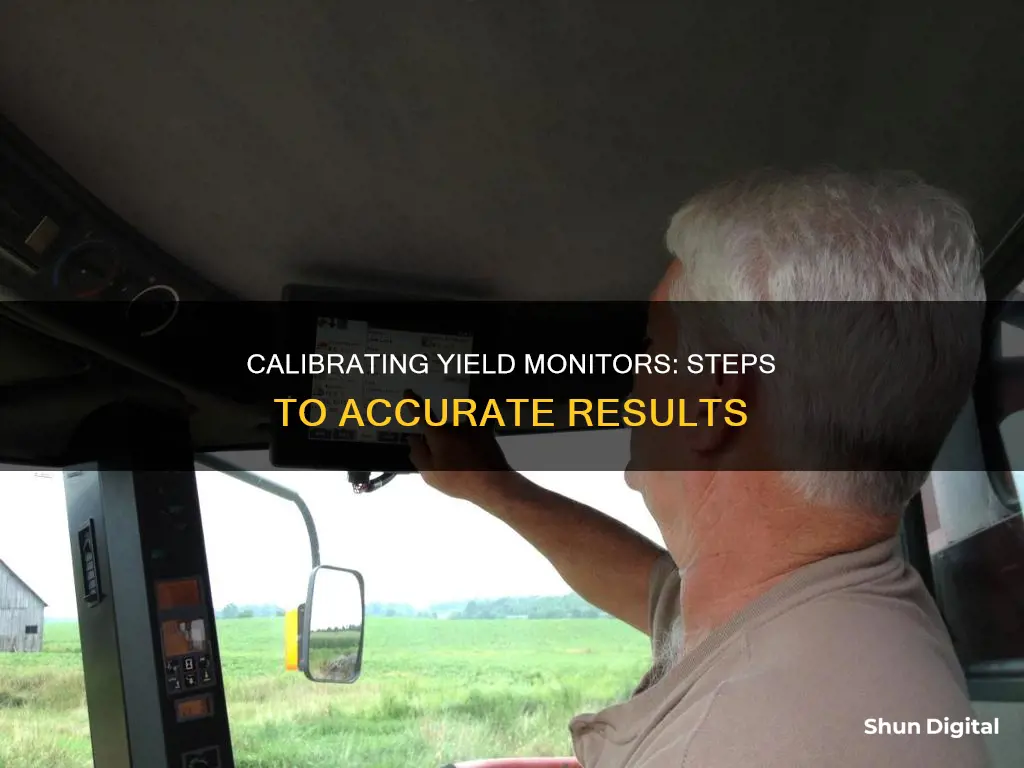
Calibrating your yield monitor is essential to ensure you're working with accurate data and making good decisions for your farm management. The calibration process can vary depending on the type of yield monitor you have, so it's always a good idea to refer to the manufacturer's guidelines. Here are some general steps and tips to help you calibrate your yield monitor effectively:
- Consult your operator's manual for exact directions on calibrating your specific yield monitor.
- The mass flow sensor is typically located at the top of the clean grain elevator on the side of the combine. It is crucial to calibrate this sensor to get accurate yield data.
- Calibrate at different grain flow rates to ensure accurate yield monitoring across high- and low-yielding areas of your field.
- Check the moisture sensor annually and calibrate it periodically for accuracy. Proper moisture readings are essential for determining the dry yield.
- Set the header position correctly to tell the yield monitor when to start and stop logging data points.
- Use a scale system to obtain a ground truth load weight for calibration. Verify the accuracy of your scale system to avoid introducing errors into your yield data.
- Recalibrate your yield monitor throughout the harvest season as crop conditions change, especially when there are significant changes in grain moisture levels.
- Regularly inspect and maintain the mechanical components of the grain handling and yield monitor system, including the sensor and the clean grain elevator chain.
| Characteristics | Values |
|---|---|
| Calibration timing | At the start of the harvest season, and throughout the season when crop conditions change |
| Calibration process | 1. Harvest a calibration load. 2. Weigh the load. 3. Enter the weight into the yield monitor display. |
| Moisture sensor | Should be checked annually and calibrated periodically for accuracy |
| Lag time | The amount of time it takes grain to flow through the combine from the header, thresher, and clean grain elevator before grain starts hitting the mass flow sensor |
| Header position setting | Tells the yield monitor to start and stop logging data points |
| Distance traveled measurement | Most yield monitors use GPS, but older systems use a backup system based on wheel revolutions and wheel size |
| Cut width | Make sure the yield monitor is set with the proper cut width |
| Mass flow sensor | Located at the top of the clean grain elevator on the side of the combine |
| Gamma correction | Adjusts the colors so an image looks more realistic |
| Brightness | Influences the color representation on the monitor |
| Contrast ratio | Indicates the difference between the whitest white and the blackest black |
| Color levels | Consist of the 3 basic colors, red, green, and blue |
What You'll Learn

Back-up data from the previous season
Yield monitor data is extremely valuable, as it provides a summary of every single decision made on your farm during the past year. It is important to back up this data from the previous season, if you haven't done so already.
To ensure the safety of your data, it is recommended to copy each season's data to a unique folder labelled with the year and yield data. It is also a good idea to maintain several backup copies of the display/raw data in different locations, in case it is lost, stolen, damaged, or modified.
To ensure that your yield monitor is functioning correctly, it is important to check all cables, connections, and sensors for wear or damage. Ensure that wiring and harness connections are tight.
For clean grain elevator-mounted moisture sensor units, make sure the sensor is clean and not damaged. Clear the clean grain elevator of old grain and debris, and check to be sure that the manual clean-out motor works on the moisture sensor.
If you have a combine with a mass flow sensor, it is usually located at the top of the clean grain elevator. Look for wear on the flow sensor's impact or deflector plate and replace the plate if it is worn or damaged. Check for any excessive wear on the grain elevator and missing or worn paddles. Ensure that the spacing between the paddles and the top of the elevator meets the manufacturer's requirements.
For combines with an optical sensor mounted on the side of the clean grain elevator, make sure the sensors are clean and not damaged. Ensure that the clean grain elevator paddles are not rubbing against the sensors.
If you have purchased a new or used combine with an existing yield monitor installed, double-check to make sure it is installed properly. Pay close attention to the mass flow sensor to ensure it is mounted securely.
Monitoring Labor: Am I Hooked Up to Machines?
You may want to see also

Check sensors for dirt build-up
Calibrating your yield monitor is essential to ensure you are using high-quality yield data to make decisions in your operation. One crucial aspect of this process is regularly checking the sensors for dirt buildup or other debris that may obstruct them. Here are some detailed instructions to help you effectively check for and address any dirt buildup on your yield monitor sensors:
Identify the Presence of Dirt:
- Review your Images: Examine your images, preferably on a large monitor, for the presence of dust spots. These spots tend to appear in the same place across multiple images, regardless of the lens used. Dust spots are more noticeable when positioned against a plain and evenly lit background, such as a clear blue sky or a white sheet.
- Utilize Different Apertures: Experiment with different apertures, especially smaller ones (e.g., f/8 or smaller), as dust particles are more likely to show up at these settings.
- Test Shot Technique: Switch your camera to Aperture Priority mode, use Matrix or Evaluative metering, and set the lowest possible ISO. Disable autofocus and select the smallest aperture available. Fill the frame with a blank target area, such as the sky or a white sheet, manually defocus the lens, and capture an image. When reviewing the image on your computer, look for dark spots, which indicate the presence of dust.
Address the Dirt:
- Refer to Your Manual: Always refer to your yield monitor's user manual for specific instructions on sensor cleaning and maintenance.
- Self-Cleaning Sensors: Many modern cameras and yield monitors have self-cleaning sensors. Consult your manual to activate this feature, which may be automatic or manually triggered.
- Air Blower: If your device lacks a self-cleaning function or if it fails to remove all debris, carefully use an air blower to blow away the dust from the sensor. Be cautious not to use a brush, as the bristles can damage the sensor.
- Professional Cleaning: If you are uncomfortable cleaning the sensor yourself or if there is still significant dirt buildup, consider taking your device to a local camera store or sending it to the manufacturer for professional cleaning and maintenance.
By regularly checking and maintaining your yield monitor sensors, you can ensure accurate data collection and decision-making for your operations.
Is the FBI Monitoring You? Signs to Watch For
You may want to see also

Calibrate the mass flow sensor
Calibrating the mass flow sensor is crucial to the accuracy of grain flow estimates and, ultimately, the yield estimates. The calibration procedure for the mass flow sensor is time-consuming but vital for accurate yield measurements. The mass flow sensor is located at the top of the clean grain elevator on the side of the combine. Clean grain is carried on paddles from the bottom of the combine to the top, where the paddles throw the grain against the sensor. The sensor has a pressure plate that converts the amount of pressure against it as a voltage reading, which is then converted to a grain flow rate in pounds per second.
To calibrate the mass flow sensor, you should:
- Harvest two to six small loads of grain (around 3,000 to 8,000 lbs depending on manufacturer specifications) at different flow rates (low to high).
- Weigh each calibration load on a grain cart or truck to get a ground truth weight for the load.
- Enter the ground truth weight into the yield monitor display.
- Collect a grain sample and determine the grain moisture content of each sample.
- Use this data when you enter the calibration data for the mass flow sensor.
It is important to note that the mass flow sensor readings may be affected by crop type, moisture content, and test weight. Therefore, operators should consider performing separate calibrations for different crops and moisture levels. Additionally, it is recommended to periodically perform calibration loads throughout the harvest season to check or improve the accuracy of the weight estimates.
Disposing of LCD Monitors: Local Solutions for E-Waste
You may want to see also

Calibrate the moisture sensor
Calibrating the moisture sensor is an important step in ensuring your yield monitor provides accurate data. Here's a detailed guide on how to do it:
Firstly, it is recommended to check the moisture sensor annually for operation and calibrate it periodically for accuracy. Proper moisture readings are essential for determining the dry yield. Even if the mass flow sensor is calibrated correctly, incorrect moisture readings can lead to erroneous yield data.
When calibrating the moisture sensor, follow these steps:
- Collect grain samples: Take samples of grain from each calibration load. Ensure you obtain a representative sample by randomly collecting grain from different parts of the load.
- Determine grain moisture content: Use a high-quality, recently calibrated meter to determine the moisture content of each grain sample. Handheld moisture meters are portable and convenient, but they may not be as accurate.
- Compare moisture readings: Compare the moisture readings from your meter with those from a federally approved moisture meter at a local grain elevator. This step is crucial as portable moisture meters can vary widely in accuracy.
- Document differences: Note the differences between your meter's estimates and the accurate meter's estimates. For example, if your meter estimates 25% moisture and the accurate meter estimates 28%, document this difference.
- Adjust moisture estimates: During the yield monitor calibration, use the documented differences to adjust the moisture estimates for the grain samples from the calibration loads.
- Repeat for each grain type: It is important to calibrate the moisture sensor for each type of grain you are harvesting, as moisture levels can vary between different grain types.
In addition to the above steps, here are some general tips for yield monitor calibration:
- Refer to the manufacturer's guidelines: Consult the manufacturer's manual for specific instructions on calibrating your yield monitor. Different yield monitors may have unique calibration requirements.
- Clean the moisture sensor: Ensure the moisture sensor is clean and free of damage. A dirty or damaged sensor can affect the accuracy of your yield data.
- Back up your data: Before calibrating, back up any data from the previous season and delete old files from your memory card or USB drive. It is recommended to keep multiple backup copies in different locations.
- Check hardware: Inspect all cables, connections, and sensors for any wear or damage. Ensure tight connections, especially for wiring and harness connections.
- Calibrate at different flow rates: Harvest calibration loads at different flow rates by varying your speed or the amount of the header engaged in the crop. This helps improve the accuracy of your yield monitor across different yield levels in the field.
- Recalibrate when crop conditions change: Throughout the harvest season, recalibrate your yield monitor when crop moisture changes. Changes in grain moisture can impact the accuracy of your calibration.
Understanding Backlit LCD Monitors: How They Work
You may want to see also

Set the header position
Setting the header position is one of the most important steps in getting accurate yield data for each field. The header position setting tells the yield monitor when to start and stop logging data points.
On the headlands, farmers usually raise the header as they turn around and then lower it again as they re-engage the crop. If the operating height is set properly, the machine will automatically stop logging data points when the header is raised, and then start again when it is lowered. This eliminates the collection of zero-yield points as the machine turns around at the ends of the field.
This setting can be fixed with post-processing of the data after harvest, but the more accurately you can operate your yield monitor in the field, the more accurate your data will be.
Tom Hanks' Ankle Monitor: Fact or Fiction?
You may want to see also







